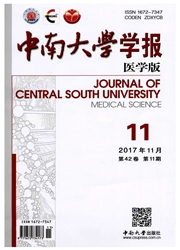

 中文摘要:
中文摘要:
目的:研究胆囊收缩素(cholecystokinin,CCK)、碳酸胆碱(carbachol,CCh)及血管活性肠肽(vasoactive intestinal peptide,VIP)体外刺激小鼠胰腺腺泡细胞肽链的延伸及其作用的分子机制。方法:采用3H-亮氨酸掺入法分别测定基础状态及CCK,CCh及VIP处理后胰腺腺泡细胞肽链延伸率;Western印迹分析基础状态和上述促分泌素处理后真核细胞延伸因子(eEF2)及其激酶磷酸化水平,进一步用MEK抑制剂(PD98059)、SAPK/P38抑制剂(SB202190)、mTOR抑制剂(rapamycin)处理细胞,分别阻断MEK,SAPK/P38和mTOR3种信号通路和磷酸酶抑制剂花萼海绵诱癌素A预处理再用CCK处理胰腺腺泡,分析eEF2及其激酶eEF2K磷酸化水平。结果:体外除VIP外,其他2种促分泌素均能诱导胰腺腺泡细胞肽链的延伸。CCK和CCh处理后真核细胞延伸因子eEF2Thr56去磷酸化及其激酶Ser366磷酸化水平增加,PD98059,SB202190和rapamycin特异性抑制MEK,SAPK/P38和mTOR信号通路以及磷酸酶抑制剂花萼海绵诱癌素A均能部分性逆转CCK诱导的eEF2去磷酸化。结论:CCK可通过MEK,SAPK/P38和mTOR信号通路诱导真核细胞延伸因子eEF2Thr56去磷酸化,参与小鼠胰腺腺泡细胞肽链的延伸调节。
 英文摘要:
英文摘要:
Objective To investigate cholecystokinin(CCK),carbachol,and vasoactive intestinal peptide(VIP)stimulating peptide chain elongation in mouse pancreatic acini in vitro and its molecular mechanism.Methods 3H-lecucine incorporation assay was used to measure the basal and secretagogues-stimulated pancreatic acini elongation rates.Western blot was applied to analyse the effect of phosphorylation of the elongation factor 2(eEF2)and the eEF2 kinase.MEK inhibitor(PD98059),SAPK/p38 inhibitor(SB202190),and mTOR inhibitor(rapamycin)were used to respectively block MEK,SAPK/p38,and mTOR intracellular pathways or the phosphatase inhibitor(calyculin A)pretreatment before CCK treatment.Results All secretagogues except VIP increased the peptide chain elongation in mouse pancreatic acini in vitro.All secretagogues except VIP inhibited the phosphorylation level of eEF2 on Thr-56 and increased the phosphorylation level of eEF2K on Ser-366,which might correlate with their activation status.MEK inhibitor PD98059 partially reversed the dephosphorylation of eEF2 induced by CCK,as did treatment p38 MAPK inhibitor SB202190,mTOR inhibitor rapamycin,and the phosphatase inhibitor calyculin A.Conclusion CCK increases peptide chain elongation via inducement of dephosphorylation of eEF2 and eEF2 kinase phosphorylation in pancreatic acini in vitro.CCK-induced dephosphorylation of eEF2 in pancreatic acinar cells involves MEK,SAPK/p38,and mTOR,the three intracellular pathways.
 同期刊论文项目
同期刊论文项目
 同项目期刊论文
同项目期刊论文
 Quantitative proteomic analysis of differential proteins in the stroma of nasopharyngeal carcinoma a
Quantitative proteomic analysis of differential proteins in the stroma of nasopharyngeal carcinoma a Proteomic analysis of the stroma-related proteins in nasopharyngeal carcinoma and normal nasopharyng
Proteomic analysis of the stroma-related proteins in nasopharyngeal carcinoma and normal nasopharyng 期刊信息
期刊信息
